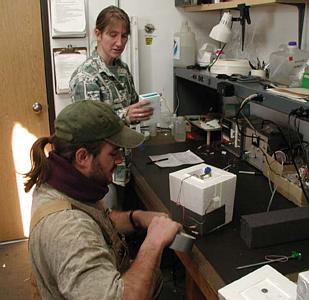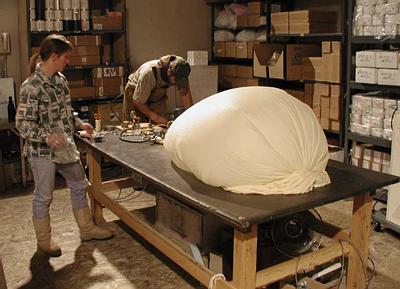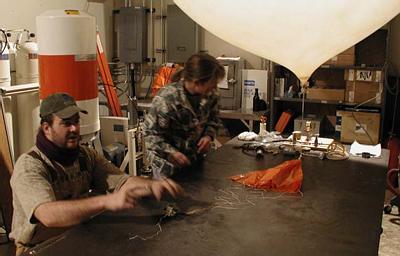4 December, 2000
Launching an ozonesonde
Sunday evenings at the south pole there is a science lecture, where one
member of the community presents the science that they are doing at the
station. Last night, Pauline Roberts Presented about her research with
the Climate Monitoring & Diagnostics Laboratory (CMDL) branch of the
National Oceanographic and Atmospheric Association (NOAA). Her talk
focused on the global climate effects that are being observed and tracked
at the south pole as well as four other locations across various
latitudes, two in the northern hemisphere, and two in the southern
hemisphere. One of the major atmospheric components that they are
collecting data on is the ozone layer.
The thickness of the ozone layer over the south pole is typically 275
Dobson Units (DU; the standard measurement of ozone thickness). Every
year around the September equinox, the combination of low temperatures,
around –60C, and sunlight as the sun rises over the pole supply the right
conditions for the ozone hole to thin. In recent years, the thickness of
the ozone layer has been around 90-100 DU during the Antarctic spring.
Data for the ozone hole have been taken since the 1961, when the level was
recorded at about 300DU, and the levels have been decreasing over time.
(more information can be found at www.cmdl.noaa.gov)
Since 1986, ozonesondes have been launched at the south pole station to
gather data on the ozone hole over Antarctica. This morning, Pauline
Roberts and Eric Sandberg launched a balloon which reached 35km up into
the atmosphere, collecting information about the ozone pressure along the
way. This data is sent via a radio signal back to the south pole station
where it is translated into a graph of time vs. ozone pressure. This
information can be compared with previous balloon flights to keep a record
of the amount of ozone in various levels in the atmosphere over many
years.

Pauline and Eric prepare the “package”; a styrofoam casing into which the detector and transmitter are housed to be carried up by the balloon.

Once the package is ready to go, the balloon can be inflated. Here Eric and Pauline begin filling the rubber balloon with helium.

The balloon is filled until it contains just enough helium to lift a mass attached to the bottom. This mass is slightly larger than the package, so the balloon will be able to lift itself and the detector through the atmosphere at about 5 m/s.

A parachute is attached to the balloon, so that when the balloon starts to fall, it will descend at a similar rate to when it lifted, and the data that was collected on the way up can be checked with data collected on the way down. Here, Pauline is finishing attaching the parachute, and Eric is getting the string in place to attach the package.

Finally, the large doors are opened, and the balloon is ready to be brought outside and launched.

Karina Leppik Choate-Rosemary Hall kleppik@choate.edu

Contact the TEA in the field at
.
If you cannot connect through your browser, copy the
TEA's e-mail address in the "To:" line of
your favorite e-mail package.
|
